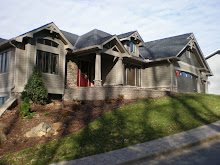Everything is relative, especially when it comes to thermal bridging. Thermal bridging occurs wherever assembly components with low R-values relative to surrounding materials span from the inside to the outside of a building assembly. Thermal bridging takes place in wood-framed assemblies because, although wood is a pretty good insulator at about R-1 per inch, it is at least three times more thermally conductive than any cavity insulation, which start at about R-3.5 per inch. With steel framing at about R.04 per inch, it is thermal bridging on a whole different scale. Steel framing typically reduces the in-cavity R-value by as much as 50%, while wood framing reduces in-cavity R-value by a bit less than 10%. As an Asheville NC Custom Builder for over twenty years we understand the negative effects associated with thermal bridging.
Wrapping a building envelope with exterior rigid insulation eliminates thermal bridging. Rigid insulation as exterior sheathing is a great idea for wood-framed assemblies, imperative for steel. But as in all things hydrothermal, you get a double benefit when you reduce or eliminate thermal bridging, you save energy and reduce the potential for condensation, mold, and rot. The main reason we put insulation in framing cavities is because there is space, it is the easiest and least expensive place to put the stuff. But it is not the best place, in large part because of thermal bridging. In what Joe Lstiburek of Building Science Corporation calls the perfect wall (or roof), all of the insulation is on the exterior. This means that the building frame experiences nearly the same conditions as the occupants, a real recipe for happy, comfortable, and long-lived people and buildings. Advantage Development Co. is an award winning Asheville NC Custom Builder that strives to have less thermal bridging in very fine home we build. Visit us today at http://www.advdevco.com/ to learn more.
Subscribe to:
Post Comments (Atom)


No comments:
Post a Comment